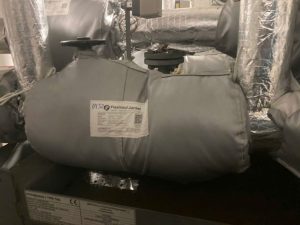In an energy industry constantly seeking to optimize efficiency and reduce costs, controlling heat loss is a key challenge. Removable insulation jackets, also known as insulation blankets, have emerged as a flexible, removable insulation solution, playing a crucial role in improving efficiency, ensuring operational safety, and cutting costs for power plants and renewable energy facilities.
What Are Insulation Jackets? A Flexible Insulation Solution for the Power Industry
A removable insulation jacket is an insulation system custom-designed and fabricated for specific equipment, allowing for easy removal and reinstallation. Unlike traditional permanent insulation methods (such as metal cladding or cement), insulation jackets allow engineers to quickly access machine parts for maintenance, inspection, or repair without destroying and replacing the insulation layer.
This is particularly useful for equipment with complex shapes that require periodic maintenance, such as turbines, boilers, valves, and pipe fittings in power plants.
Typical Structure of an Industrial Insulation Jacket
A high-quality insulation jacket is typically composed of three specialized material layers to ensure superior insulation performance and durability:
- Outer Cover: This is the layer exposed to the environment, usually made from coated Silicone, Teflon, or fiberglass fabric. This layer is responsible for resisting water, oil, chemicals, UV radiation, and mechanical impacts within the plant environment.
- Insulation Core: This is the heart of the insulation jacket, determining its heat retention capability. Common materials include Ceramic Fiber, Glass Wool, or Aerogel, selected based on the equipment’s operating temperature. The thicker the core layer, the higher the insulation performance.
- Inner Liner: This layer is in direct contact with the hot surface of the equipment. It must withstand very high temperatures and is typically made from fiberglass fabric or stainless steel mesh to prevent deformation or degradation.
The entire system is secured with specialized stainless steel straps, buckles, and hooks, making installation and removal quick and convenient.
Applications of Insulation Jackets in Power Plants & Renewable Energy
Thanks to their flexibility and effectiveness, insulation jackets are widely used for many critical pieces of equipment in the power industry.
Thermal Power Plants (Coal, Gas)
- Steam & Gas Turbines: Insulating the turbine casing helps maintain a stable operating temperature, increases the efficiency of the steam cycle, and protects sensitive components from thermal fluctuations.
- Boilers: Insulating the boiler body, inspection doors, valves, and header pipes minimizes heat loss to the environment, leading to significant fuel savings.
- Piping Systems & Valves: Steam pipes, valves, and flanges are major points of heat loss. Insulation jackets help maintain the temperature and pressure of the fluid, while also protecting personnel from burn hazards.
- Flue Gas Treatment Systems: Maintaining heat in the flue gas ducts helps pollution control systems (e.g., SCR) operate at their optimal temperature, improving treatment efficiency.
Renewable Energy
- Biomass Power Plants: Similar to thermal power plants, insulation jackets are used on boilers, turbines, and piping systems to optimize electricity generation.
- Geothermal Power Plants: Insulating geothermal steam pipes and turbines minimizes temperature and pressure drops during transport, maximizing electricity output.
- Concentrated Solar Power (CSP) Plants: Insulating pipes that carry heat transfer fluids (e.g., molten salt) ensures maximum thermal energy is conserved on its way from the receiver tower to the power block.
Superior Benefits of Using Insulation Jackets in the Power Industry
Investing in an insulation jacket system brings tangible, measurable benefits to power plants.
- Improved Energy Efficiency: Reducing heat loss means less energy input is needed to maintain operating temperatures, directly increasing the plant’s overall efficiency.
- Reduced Operating Costs: Lowers fuel consumption (coal, gas) and energy costs. The payback period for investing in insulation jackets is often very short, ranging from a few months to just over a year.
- Enhanced Workplace Safety: Reduces equipment surface temperatures to a safe level (typically below 60°C), effectively preventing burn accidents for operations and maintenance staff.
- Shorter Maintenance Times: The ability to quickly remove and reinstall jackets shortens equipment downtime, optimizing production time and reducing labor costs for each maintenance cycle.
- Equipment Protection and Extended Lifespan: Maintaining stable operating temperatures reduces thermal shock, which helps extend the lifespan of critical mechanical components.
- Noise Reduction: The thick insulation layer also acts as an acoustic barrier, helping to reduce noise levels in the work environment.
- Flexibility and Reusability: Easily removed for inspection and maintenance without damaging the material. Insulation jackets can be reused for many years, saving on replacement costs compared to permanent insulation.
For a detailed consultation and quote on insulation jacket solutions for your plant, contact our team of experts today!
Request consultation and quotation now!Frequently Asked Questions
What is the maximum temperature an insulation jacket can withstand?
Depending on the materials used, insulation jackets can be designed to withstand temperatures from a few hundred degrees Celsius to over 1200°C, suitable for most applications in a power plant.
How does the cost of an insulation jacket compare to permanent insulation?
The initial investment cost for an insulation jacket may be higher, but due to its reusability and labor cost savings during each maintenance cycle, the long-term total cost of ownership is often significantly lower than that of permanent insulation, which must be destroyed and replaced.
How do I choose the right type of insulation jacket?
The selection depends on factors such as operating temperature, working environment (indoor/outdoor, chemicals), and the size and shape of the equipment. You should consult with a professional supplier for advice on the optimal solution.
How long does it take to install an insulation jacket on a turbine?
Thanks to their custom-fabricated design, installing insulation jackets is very fast. Depending on the turbine’s size, the job can take just a few hours to a day, which is much quicker than installing traditional permanent insulation.










